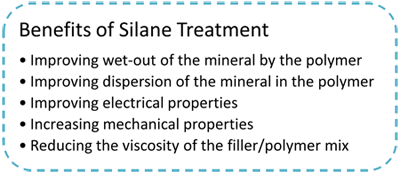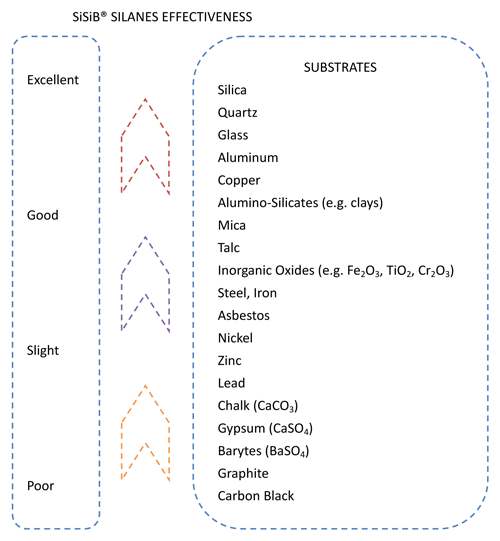Silanes for Fillers and Pigments
 |
| Inorganic minerals like kaolin, clay, talc, mica, or quartz are widely used as fillers in the thermoplastic or rubber composite industry. Also, functional fillers like ATH (aluminium trihydrate) or MDH (magnesium hydroxide) as well as inorganic pigments like TiO2 are used to modify organic resins. Silane are used for high quality surface modification, the mineral surface of the filler or pigment can be made hydrophobic to be more compatible with hydrophobic organic resins. The hydrophobation that occurs when the alkylsilane binds to the filler particle’s surface allows for improved dispersion into the resin. |
| Much more effect | Silica, alumina, glass, quartz, porcelain clay | |
| Much effect | Mica, talc, clay, water and alumina, grammiteiron dust, potassium titanic acid | |
| Ratherish effect | Asbestos, ferric oxide, zinc oxide, carborundum, silicon nitride | |
| Not very effect | calcium carbonate, carbon, barium sulphate,boron |
 |
| There are three general methods for treating the surfaces of inorganic filler materials before they are added to the organic resins. |
| Wet Method | |
| By mixing a slurry of the inorganic materials in a dilute solution of the silane coupling agent, a highly uniform and precise surface treatment of the inorganic material can be obtained. | |
| Dry Method | |
| A high shear, high speed, mixer is used to disperse the silane coupling agent into the inorganic materials. The silane is generally applied either neat or as a concentrated solution. When compared to the Wet Method, the Dry Method is most often preferred for large-scale production, treating a large amount of filler in a relatively short time and generating relatively little mixed waste; however, it is more difficult to obtain uniform treatment with this method. | |
| Spray Method | |
| Spray the silane coupling agent on high temperature filler that was just taken out from furnace. The method may omit dry procedure and make the process simplify, but pay attention to perflation and ignite. |
| 1) CALCULATING THE QUANTITY OF SILANE REQUIRED: The silicone molecule is preferably attached to the surface of the inorganic material as a primer to form a mono-layer. Applying a silane as a primer will produce optimum coupling results between the substrate and the resin to be applied. When used as a primer the required amount of silane can be calculated by the following: | |||||||||||||||||||
 |
|||||||||||||||||||
| The actual values may deviate from the calculated value depending on the surface condition of the filler or the silane treating process. The following values may be used as guidelines when the value is unknown. A dilution of 1% silane to filler may be considered as standard. Generally 0.3% to 0.5% is recommended. | |||||||||||||||||||
|
|||||||||||||||||||
| 2) REACTIVITY: The alkoxy groups of the coupling agents react with water to form silanol groups which immediately form covalent bonds by dehydration and condensation: | |||||||||||||||||||
 |
|||||||||||||||||||
| Product Name | Minimum Coverage Area(m2/g) |
| SiSiB® PC1110 | 436 |
| SiSiB® PC1100 | 353 |
| SiSiB® PC3100 | 330 |
| SiSiB® PC4100 | 314 |
| SiSiB® PC2300 | 398 |
| SiSiB® PC1220 | 380 |
| SiSiB® PC1200 | 351 |


